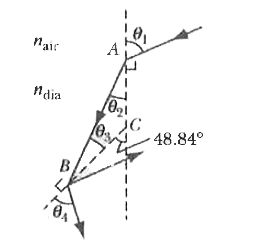Sparkle in the diamond
The purpose of a diamond is, of course, to sparkle . Part of the art of cutting a diamond is to ensure that all the light entering through the top face or side facets leaves through those surfaces, to participate in the sparkle. Figure 34-18 shows part of a cross-sectional slice through a brilliant-cut diamond, with a ray entering at point A on the top face. In this type of cut, the top and bottom surfaces have normal lines that intersect at the indicated 48.84∘. At point B, at least part of the light reflects and leaves the diamond properly , but part could refract and thus leak out of the diamond. Consider a light ray incident at angle θ1=40∘ at A. Does light leak at B if air (n4=1.00) lies next to the bottom surface ? Does light leak if greasy grime (n4=1.63) coats the surface? The index of refraction of diamond is nd∈=2.419.
When light reaches the interface between two materials with different indexes of refraction (call them n1 and n2 ), part of all of the light is reflected. The reflection is total if (1) the incident light is in the material with the higher index of refraction (n1>n2) and (2) the incident angle exceeds a critical value given by Eq. 34-10
θ=sin−1(n1n2)
If those two conditions are not met, part of the light is refracted across the interface according to Snell.s law.
Case 1 : Clean diamond
We need to follow the light from point A to point B to see if it can leak at point B. The light incident at point A is in the material (air n1=1.00) with a lower index of refraction than the material on the other side of the interface (diamond ndia=2.419). Thus, some of the light is refracted across the interface (the reflected portion is not shown in Fig. 34-18), and we find the angle of refraction from Snell.s law
Calculation :
θ2=sin−1(sin40∘2.419)=15.41∘
Now, note that the given angle of 48.84∘ at point C is an exteriror angle of triangle ABC and thus (from Appendix E), we can write
θ3+θ2=48.84∘
or θ3=49.84∘−θ2=33.43∘
This is the angle of incidence of the ray at point B. Now the incident light is in the material (diamond) with the greater index of refraction than the material (air) on the other side of the interface. However, if we apply Snell.s law at point B, we find no answer. The reason is that the light is incident at an angle greater than the critical value of
θcsin−1(n4ndia)=sin−1(1.002.419)=24.4∘
Thus, all the light reaching B reflects and none leaks out in the air.
Case 2 : Grimy diamond
We again follow the light from A to B, with the only difference lying in the last two calculations.
Now at B, the material on the other side of the interface is grime with an index n4=1.63. The incident light is again in the material with the greater index, but now the critical angle is
θc=sin−1(n4ndia)=sin−1(1.632.419)=42.4∘
Therefore, the incident angle n3=33.43∘ is less than the critical angle and light leaks through the bottom of the diamond.
From Snell.s law, the angle of refraction is
θ4=sin−1(2.4191.63sin33.43∘)=54.8∘
Learn Thus, to keep a diamond sparkling, clean both the top and bottom surfaces.

Topper's Solved these Questions
- GEOMETRICAL OPTICS : REFRACTIONBOOK - RESNICK AND HALLIDAYCHAPTER - GEOMETRICAL OPTICS : REFRACTIONEXERCISE - Check point
6 Videos
- GEOMETRICAL OPTICS : REFRACTIONBOOK - RESNICK AND HALLIDAYCHAPTER - GEOMETRICAL OPTICS : REFRACTIONEXERCISE - Problems
44 Videos
- GEOMETRICAL OPTICS : REFLECTION BOOK - RESNICK AND HALLIDAYCHAPTER - GEOMETRICAL OPTICS : REFLECTION EXERCISE - PRACTICE QUESTIONS (Integer Type)
3 Videos
- GRAVITATIONBOOK - RESNICK AND HALLIDAYCHAPTER - GRAVITATIONEXERCISE - PRACTICE QUESTIONS (INTEGER TYPE)
4 Videos
Similar Questions
Which of the three drawings here (if any ) show physically possible refraction?

View SolutionIn an oscillating LC circuit with L=79mH and C=4.0 μF, the current is initially a maximum . How long will it take before the capacitor is fully charged for (a) the first time and (b) the second time ?
View SolutionA girl with two normal eyes want to see full width of her face by a plane mirror. The eye- to - eye and ear- to -ear distances of her fave are 10 cm and 14 cm, respectively. Find the minimum width of required mirror.
View SolutionGraviational acceleration on the surface of plane fo √611g. where g is the gracitational acceleration on the surface of the earth. The average mass density of the planet is 23 times that of the earth. If the escape speed on the surface of the earht is taken to be 11kms−1 the escape speed on teh surface of the planet in kms−1 will be
View SolutionA cut diamond sparkles because of its
View Solutionहीरे का चमकना ____ की घटना है।
View Solutionहीरे की चमक का कारण क्या है ?
View SolutionA diamond sparkles because of its
View SolutionA cut diamond sparkles because of its
View SolutionWhy does a diamond sparkle with great brilliance?
View SolutionSparking of diamond is due to
View SolutionThe sparkle of a diamond can be explained by which phenomenon of light ?
View SolutionWhy does diamond sparkle ?
View SolutionProperly cut diamond sparkles because
View SolutionA : हीरा खूब चमचमाता है।
R : हीरा, प्रकाश अवशोषित नहीं करता ।
View SolutionWhy does a diamond sparkle?
View Solution

